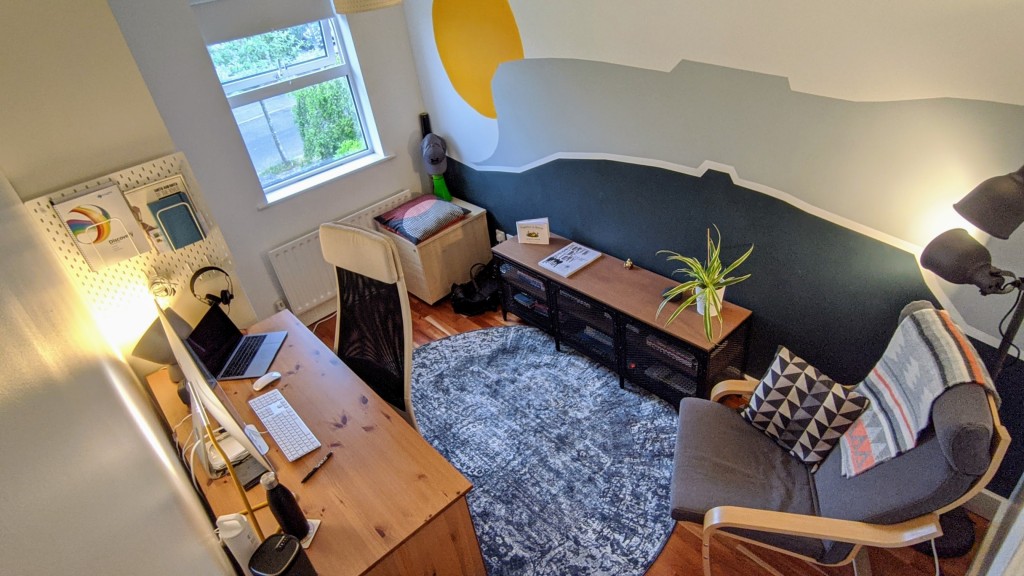
Interview with Paul, a remote product designer who has found his zen
How did you get started with remote work?
Like many around the world today, the Covid-19 pandemic saw me retreating from the office to the safety of home, where Ireland announced a national lockdown back in March. Fortunately, the move was quite seamless as the company I work for —Global Payments—uses GSuite.
I have teammates and colleagues based in the United States and India, so it makes no difference whether I am sitting in the office or at home when on a Google Meet call with them.
As it happens, prior to the pandemic, the idea of working remotely more often was beginning to appeal to me. I wasn’t too sure when to take the plunge but was on the verge of doing a couple of trial weeks when the pandemic fast-tracked all that. Covid-19 anxieties aside, I’ve enjoyed it so far.
Read 114 answers from other remote workers
What are you working on?
I’m a Senior UX Designer with a focus on Design Operations. A key focus of my role is to understand how we can truly connect designers distributed across regions so that we can work together to share knowledge and success stories.
Recently, I, along with a colleague based in Texas, ran a remote design sprint session with the team. The purpose was twofold —connect the team with a common project while also seeing how we could adapt the design sprint to a remote setting.
Another project I am part of is developing our design system to support our mission to elevate design in Global Payments. This allows us to deliver unified experiences across all of our products, solutions, and services worldwide.
I’m also interested in what the prolonged remote working ‘experiment’ will mean for the future of how we work. I’m part of an initiative in our Dublin office conducting research to gather insights and data on the impact of remote work to help inform future decisions.
Read 107 answers from other remote workers
What do you like about remote work?
The flexibility. Also, it means less time commuting and more time for what’s important. I can design my ideal workday - within the constraints of the work I need to do.
I can focus on my work in a comfortable way; for example, I like to listen to music when I work, but having headphones on in the office all day is not very social and not all that comfortable.
At home, I can turn on the Sonos and play whatever I choose, without annoying anyone else or my ears!
Read 106 answers from other remote workers
What do you not like about remote work?
As humans, we have a need to belong and feel connected.
Admittedly, there’s an energy you can only get when you meet with people face to face. I miss that—but it is my belief that in a time when COVID is less of an issue, that will return.
I feel that there can be a balance between working from home and going to the office.
Read 103 answers from other remote workers
What tools do you use to stay productive?
The main tools I use are the Bullet Journal, supported by Google Calendar and the Time Timer. In my search to find a way to take better notes and to-do lists, I discovered the Bullet Journal (BuJo). This brought order and structure to how I captured notes and to-do lists that had previously been random and sometimes chaotic.
It looks like just a regular dotted notebook, but it's actually an analog system that helps track the things I need to do, the things I have done, and schedule them.
The act of physically writing things down is quite mindful and helps me be more intentional about what I need to do.
I also use the BuJo to write my daily gratitude log. When I am in the flow of using the BuJo, I feel in control of things. When I fall out of the flow, I don't feel as in control.
I use Google Calendar to support entries in my notebook and block out time for things that are important to me. At a high level, this breaks down to Personal / Family Time, Laser Focus Time, and Open / Collaborative Work time.
This helps to balance my week and understand when I have time to focus on things. These tools also allow me to know when I can schedule meetings or collaborative work, and when I can be with my family or have some time out.
The Time Timer is a little clock that sits next to my monitor and helps create a sense of urgency for each task.
After that, it's GSuite for communicating and collaborating with colleagues, Figma for design work and Miro for virtual whiteboarding.
I wrote more detail about this approach in "Building Blocks of Time Creating Balance and Structure for Work & Life Under the Same Roof" published on Medium
Read 108 answers from other remote workers
Where do you conduct your work?
Initially, it was a desk in the corner of the spare room. This worked fine, to begin with, but a spare room can become the dumping ground for laundry and miscellaneous items (usually en route to the attic!). This can be a distraction. So I moved into the smaller room and set up a dedicated home office.
Read 15 answers from other remote workers
What about your space helps you to be productive?
It’s a dedicated space, and when I step in and close the door behind me, the room is instantly calming.
It’s the only ‘kid-free zone’ in the house, but I also like to call it my zen zone.
I’ve kept it quite minimal by design —using whites, greys, and wood in the colours and materials. A green lava lamp (that I’ve had since I was a teen) provides a pop of colour and compliments the spider plant.
I have things in here that bring me joy —a couple of U2 records, my guitar, my Sonos speaker. A grey circular rug on the floor helps define the ‘workspace’ while a chair sitting just off the rug is where I can retreat to read, meditate, or jam on the guitar.
There’s a place for everything, so the room remains clutter-free: a pegboard beside the desk to hang my headphones and cables; the desk has storage while I also picked up a TV stand from Ikea, which is now acting as a space for my books. It’s a fine balance in a relatively small space, but it works and helps keep me focused.
Read 15 answers from other remote workers
What does your workday routine look like?
I have blocked out my workdays to start at 9 am and finish at 5.30 pm. In between, I have blocked out time for focus work, collaborative work, and breaks (coffee, lunch).
At either end of the day is personal time. In the morning, I mock the commute by getting out for a walk or exercise during the time I would usually have been commuting. I make time in the evening to have dinner and spend time with my family before the boys go to bed.
Here’s an example of a typical day:
07.15–09.00 — Mock The Commute & Gratitude Log I have replaced my usual commuting time with mocking the commute, having breakfast, writing my gratitude log, and starting my to-do list. I also have extra time to spend with my son by getting him dressed and preparing his breakfast.
9 am — Laser Focus Block Time to start work and prepare for the day and week ahead.
10.30–10.45/11.00: Coffee Time! First break — Time for coffee!
10.45–12.30: Open Work Time Back to work, but this block of time is open, so I am available and ready to take or schedule calls if required. I usually have my 1:1 with my line manager during this time.
12.30–13.30: Lunch — Bonus Family Time I need to eat to remain energised. It’s also an opportunity to spend some time with my wife and boys and, on fine days, have lunch al fresco in the garden —both bonuses I am grateful for during these strange times.
13.30–16.00: Open Work Block It’s back to work and another open block. We usually have our team huddle during this time to update one another on our focus areas for the week ahead.
16.00 — Break Time for an afternoon break. Right now, we have a virtual team hangout to connect with teammates on a more personal level, so I will aim to join this as often as possible.
16.30–17.30: Open Work Block The last hour is about wrapping up tasks and activities for the day and responding back to any outstanding emails. It’s open for any additional meetings that need to happen.
17.30–20.00: Family Time This is sacred family time. We have dinner together, then I get to play with the kids before it’s their bedtime. Bedtime consists of three stories, and it’s a wonderful moment of connection between parent and child. I’ve become a huge admirer of the work of Julia Donaldson!
20.00: Personal Time This is flexible personal time — I can take it for myself to draw, listen to music, go for a run, watch a TV show, spend time with my wife, connect with friends and family.
My personal blocks remain the same every day.
Read 16 answers from other remote workers
How do you decide priorities?
This depends on my objectives and project deadlines.
Read 40 answers from other remote workers
How do you avoid burnout?
I’ve burnt out before, so I can more readily recognise the signs if and when the flame starts to flicker.
For me, it’s taking a break by getting out in nature every day, exercising, meditating, or practicing gratitude.
Read 17 answers from other remote workers
What is the best advice you have ever received?
You cannot control the weather.
It may seem a strange one, but it came at a time when there was a lot going on in my personal life, and this advice enabled me to focus back in on myself; to look after myself first so I could look after others.
Control the controllable and let go of everything else.
It was like a weight off!
Related to that is a line from the great comedian Billy Connoly where he once said,
It’s only weather, there is no such thing as bad weather, there’s only the wrong clothes
It’s all about perception and mindset.
Read 16 answers from other remote workers
What advice would you give to a new remote worker?
Structure and routine are vital. As are taking breaks and allowing for personal time to catch up with family, friends, and yourself.
Without the commute, coffee breaks, lunch, and impromptu chats that usually punctuate the office day, work, and home life can easily mesh into one.
Usually, work will overtake the other. This will lead to burnout!
Read 13 answers from other remote workers
What are you looking to achieve in the next five years?
I would like to be a champion for remote work and create moments people connect with through my work—whether it be writing, designing or just lending a helping hand or sharing a piece of advice.
I felt at times before the pandemic that I was another rat in the rat race.
We’d all hop off the train each morning with our headphones feeding us the musical tones of our respective favourite artists, or the musings from our favourite podcasts.
No one would talk to anyone; we’d just scurry off to our offices and repeat the exercise that evening on the way home. If anything I feel the pandemic has brought real connection between people and I hope this continues. Balance and focusing on what’s important is key for the future of how we work.
Read 11 answers from other remote workers
What did we forget to ask Paul Gillen ?
At RemoteHabits we're always trying to improve our interviews, what question should we have asked Paul Gillen ?
Biography
Paul Gillen
Paul is a husband, father, designer, and optimist with a passion for innovation, creativity, well-being, and a good story. Paul has worked in Customer Operations, Marketing, and Design roles since graduating from Letterkenny IT (Ireland) as a Graphic Designer in 2003. A native of Sligo, Ireland (on Ireland’s breathtaking Wild Atlantic Way) Paul is based in Dublin and has been with Global Payments (Realex Payments until the 2015 acquisition) for over 12 years, working across all aforementioned roles.
Work remotely? Share your story on RemoteHabits!
Want to be interviewed? If you have a remote position, head over to the interview me page!
Looking for a remote job?
RemoteHabits Jobs has everything you need to find your next great remote work position!
Related Interviews
Interview with Emma, a freelance marketing consultant
Emma is thriving as a freelance marketing consultant—see her tips on managing client demands & making yourself marketable as a freelancer.
Interview with Pamela, a travel writer adjusting to freelancing
Pamela is new to the world of freelancing. In this interview, she shares the ups and downs of adjusting to the gig economy.
Interview with Michael, a VFX artist that works remotely
Michael is a freelance visual effects (VFX) artist, creating 3d models, mockups and videos while working remotely.



